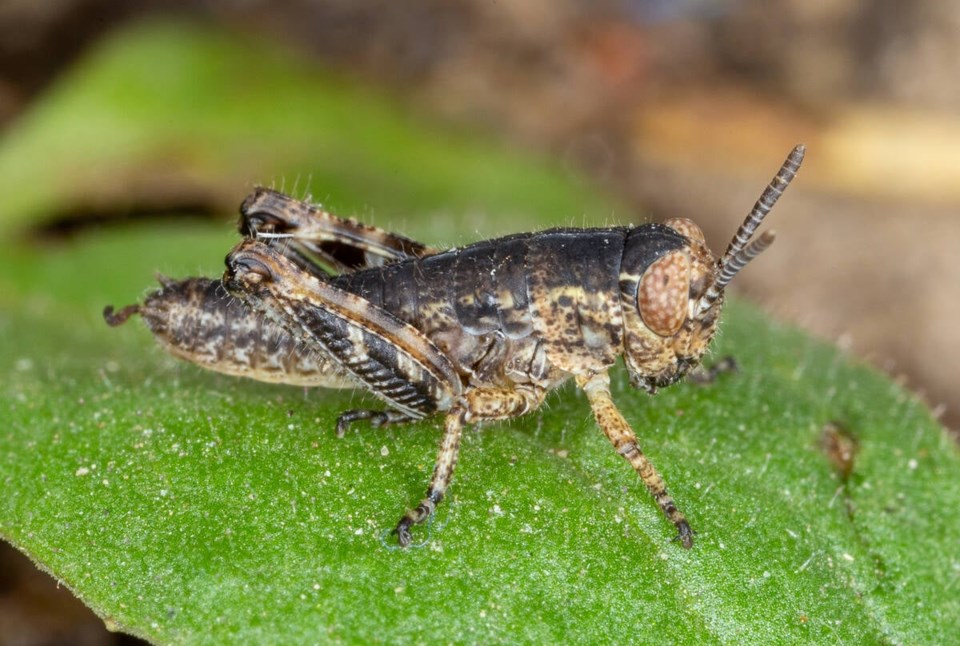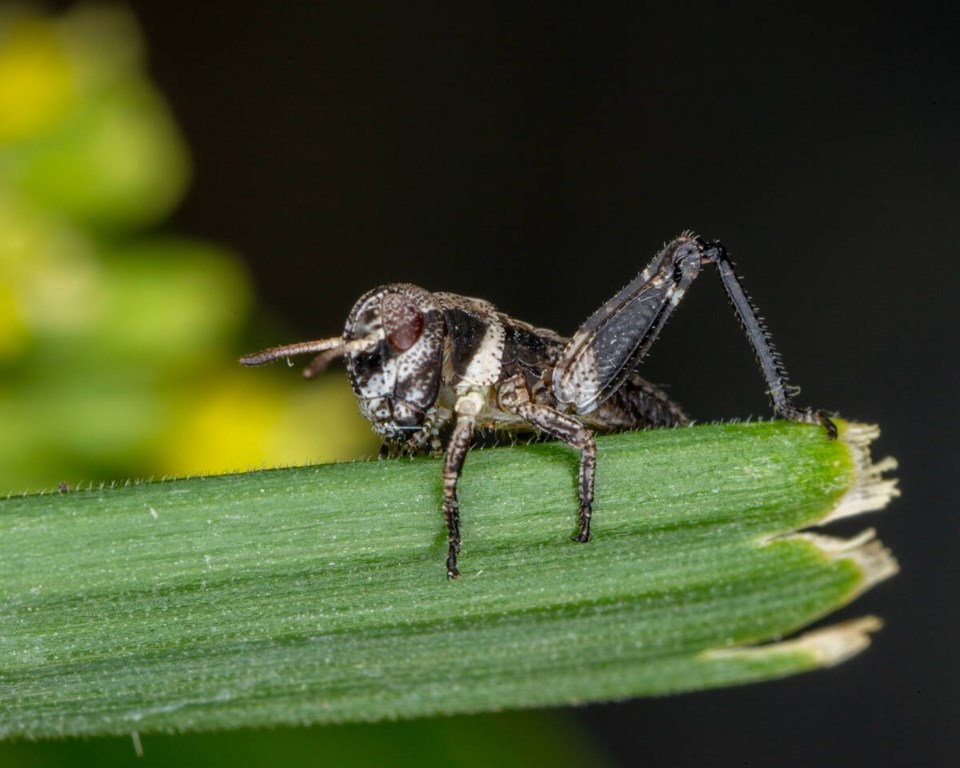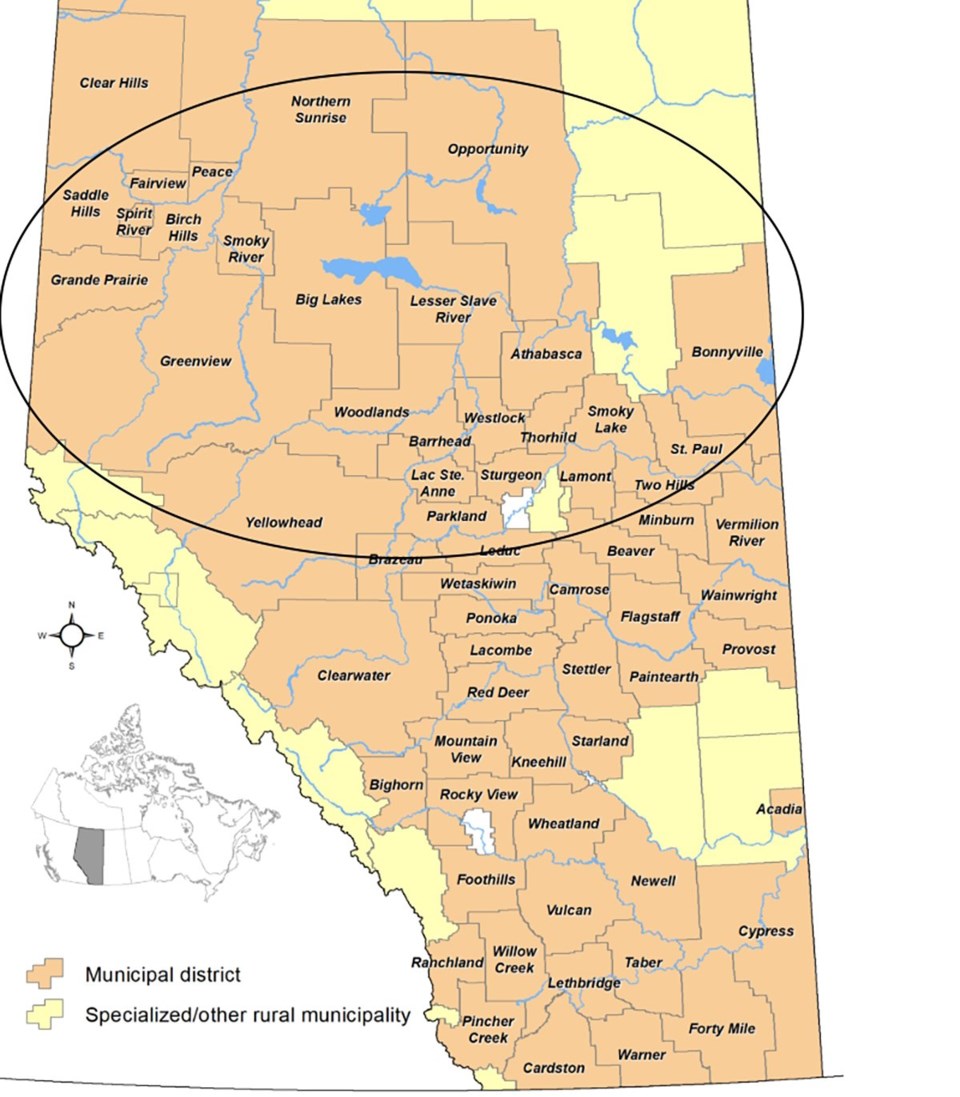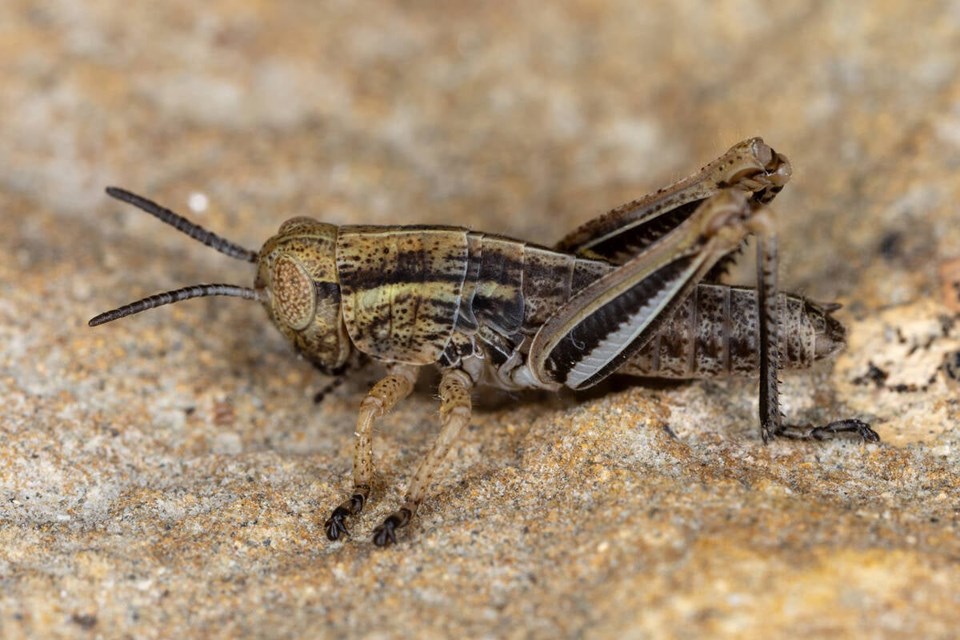WESTERN PRODUCER — June’s arrival marks the sweet spot where farmers should start scouting their fields for grasshopper pests.
However, not all grasshoppers are created equal when it comes to their threat level. Of the more than 80 species of grasshoppers on the Canadian Prairies, only approximately 10 cause problems for agriculture producers.
On individual farms, particular attention should be paid to areas that traditionally have higher grasshopper populations.
As well, grasshoppers tend to lay their eggs near areas of green growth in the fall, which will provide potential food sources for emerging young the following spring. Areas with early green plant growth such as field margins, fence lines and roadsides are also areas that will give early indications of potential grasshopper problems.

The Bruner’s spur-throat is the grasshopper pest found most commonly in the northern regions of Alberta. | Photo: Dan Johnson
As farmers trudge through their fields with their nets to capture small grasshoppers for inspection, they should pay close attention to colour patterns.
The silver/grey ones are not pests.
Instead, farmers should be worried about the two-stripe grasshoppers, which are brown with a solid stripe on their back leg.
Another destructive grasshopper is the clear-winged, which flies well and is blotchy yellow and tan, although it is black and white when it first hatches. This makes for vigilant monitoring starting in late May and June and throughout the summer.
“It can be a little confusing at times with the immatures,” said Dan Johnson, professor of environmental science at the University of Lethbridge with decades of experience with grasshoppers, specializing in entomology.
 This newly hatched clear-winged grasshopper can be found in the Oyen region in Alberta and the Estevan and Kindersley areas in Saskatchewan. | Photo by Dan Johnson
This newly hatched clear-winged grasshopper can be found in the Oyen region in Alberta and the Estevan and Kindersley areas in Saskatchewan. | Photo by Dan Johnson
“They can look quite different than they do in July, going through five stages. Some (species) completely change their appearance, others don’t.”
The grasshopper survey is based on counts of the numbers of adult grasshoppers in late July and August, recorded by Agricultural Fieldmen of Alberta.
Alberta Agriculture turns these late-summer counts into a map to show the potential for the following year.
The Alberta grasshopper forecast was the first geographic information system for forecasting insect numbers and started in the 1980s in Lethbridge. The counting and production of colour maps goes back to the 1930s.
The two-stripe is the common southern Prairie pest, but different regions can have different grasshopper problems, such as the Bruner’s spur-throat grasshopper going further north in the foothills and Cypress Hills, Peace River and Cold Lake regions.
“It is the dominant species up there, 60 to 65 per cent, but all grasslands in most of Alberta does not have it at all. The two-stripe goes all the way from the north to the south covering the whole province,” said Johnson.
Of the grasshoppers that cause problems, certain species are attracted to certain crops.
Bruner’s feeds mainly on broad-leaf plants, hammering crops such as alfalfa. When it gets into wheat and barley, it will strangely feed on the thistle while largely leaving the wheat and barley alone for the most part, he added.
“Whereas the two-stripe eats everything — canola, wheat, barley, you name it,” said Johnson.
The clear-winged feeds on grasses with wheat and barley and is found in the Oyen region of Alberta and the Estevan and Kindersley areas in Saskatchewan.
“If it goes into a canola field, it will leave, or flax or alfalfa. It almost doesn’t touch them.”
Spring temperatures have only a minimal effect on the survival of grasshoppers that hatch.
Young grasshoppers are hardy enough to survive low, even below freezing spring temperatures, providing these temperatures do not persist for several days.
If the spring is hot, grasshoppers will hatch early and develop quickly. Cool spring temperatures will slow development.
Rain was falling in southern Alberta as Johnson talked with the Western Producer, which acts as a deterrent for hatchlings.

The circled area is where the Bruner’s spur-throat grasshopper is predominately found. | Photo: Courtesy Dan Johnson
Rain in late May slows the growth of hatchlings and can kill a portion of them, but rain does not affect the eggs still in the ground.
When the soil warms above 14 C, they will continue to hatch. Rainfall will only have a huge effect if a heavy downpour occurs immediately following an extensive hatch.
Surprisingly, the number of grasshoppers one finds in a field will not necessarily be proportionate to the amount of damage, but rather Mother Nature and the type of grasshopper that is found.
“The thing about grasshoppers is (number) thresholds don’t work really well like other pest insects. Sometimes 10 per sq. metre is bad and 100 is not bad,” said Johnson.
“It mostly depends on two things: species and the weather. If it’s warm, they’ll do damage more rapidly, and that’s the time to take a look. If you’re not seeing damage, then it’s either the wrong type of grasshopper, they don’t have an affinity for that crop or there’s something with the weather that holds them back.”
Farmers who are unsure of the types of grasshoppers they are seeing in their fields can send pictures to Johnson at [email protected].
Related Coverage

